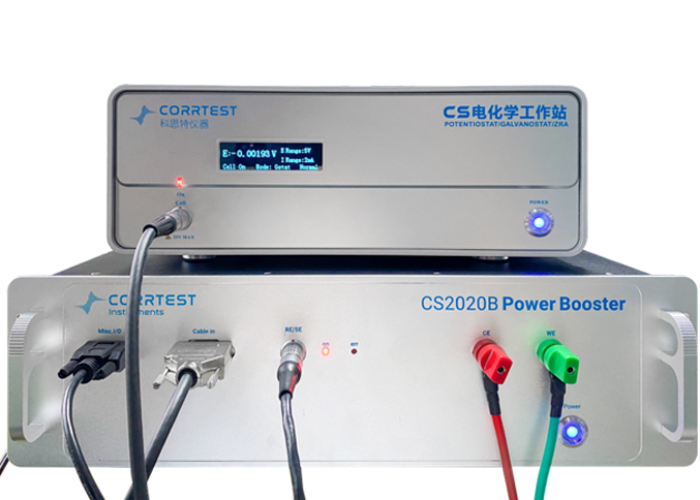Current Boosters
Current boosters extend the output range of potentiostats for high-current applications such as electroplating, industrial electrolysis, and battery pack testing.

20A/40A/100A Current Booster
- Potential range: ±10V(CS2020B) / ±5V(CS2040B) / ±5V(CS2100B)
- Current range: ±20A(CS2020B) / 40A(CS2040B) / 100A(CS2100B)
- Current range: 20A/40A/100A fixed range
- Compliance voltage: ±13V (when output±20A limit current, maximum output ±10V@20A)
Current Boosters for Electrochemical Applications
Current boosters for electrochemical applications are specialized devices designed to extend the current output capabilities of potentiostats or electrochemical measurement systems. They enable researchers to perform experiments that require higher currents than the base instrument can supply, which is essential in applications such as fuel cell research, supercapacitors, battery testing, and electroplating
1. High-Current Applications
Current boosters are widely used in:
- Battery and Supercapacitor Testing: For charge/discharge cycles of large-format cells requiring currents up to 100A or more.
- Fuel Cell Research: To simulate real-world operating conditions with high current loads.
- Electroplating and Electrolysis: For industrial-scale processes needing sustained high currents.
- Photovoltaic and Solar Applications: Where modules or cells are tested under high current scenarios.
Common booster ratings include 20A, 40A, and 100A high-current expansion modules, supporting both single and multi-channel potentiostats.
2. Features and Functionality
Key features of current boosters for electrochemical applications include:
- Modular Design: Plug-and-play modules that can be added or removed as needed, supporting easy upgrades and maintenance.
- Wide Current Range: Options from ±1A to ±100A, with some systems allowing parallel operation for even higher currents.
- Voltage Compliance: Typical voltage ranges from ±5V to ±48V, depending on the booster model.
- EIS Capability: Many boosters support Electrochemical Impedance Spectroscopy (EIS) at high currents for advanced analysis.
- Integrated Safety: Features like current protection, short-circuit protection, and emergency shut-off to ensure safe operation at high power levels.
- Software Integration: Automatic detection and configuration via control software, enabling streamlined experiment setup and data acquisition.
- Thermal Management: Advanced cooling solutions (fans, heat sinks) to handle heat generated during high-current operation.
3. Integration and Wiring
Integration and wiring considerations for current boosters:
- Compatibility: Boosters can be connected to single-, bi-, or multi-channel potentiostats, but typically only one channel per booster.
- Connection Kits: Standard supply includes power cables, serial and connection cables (DB9, DB15), electrode cables (alligator/copper terminal), and high-power dummy cells for calibration and testing.
- Parallel Configuration: Some systems allow multiple booster modules to be connected in parallel, significantly increasing the total available current (e.g., up to 150A).
- Wiring: High-current boosters require robust, low-resistance wiring and secure terminal connections to ensure safe, efficient power delivery.
- Plug-and-Play: Many modern boosters offer plug-and-play installation, with hot-swappable modules and automatic software recognition.
Example: Science Gears Offer
- Current Boosters Available: 20A, 40A, and 100A high-current expansion modules.
- Application: Suitable for upgrading standard potentiostats to handle industrial-scale electrochemical experiments.
Summary
Current boosters are vital for high-power electrochemical applications, offering modularity, advanced safety, and seamless integration with modern potentiostats. Options from 20A to 100A (and beyond) are available, with features tailored for demanding research and industrial environments.
FAQs
1. What is a current booster in electrochemical applications?
A current booster is an external hardware module that increases the current output capability of a potentiostat or electrochemical workstation, enabling high-current experiments such as battery testing and fuel cell evaluation.
2. Why do I need a current booster for my electrochemical experiments?
Standard potentiostats often have limited current output (typically a few amps). Current boosters allow researchers to perform experiments requiring higher currents (e.g., 20A, 30A, 100A), essential for large-format batteries, fuel cells, or industrial electrolysis.
3. What current ranges do typical boosters support?
Common current boosters support ranges like ±20A, ±30A, ±40A, and up to ±100A. Some systems allow parallel operation of multiple boosters to achieve even higher currents (e.g., up to 150A).
4. Can current boosters perform Electrochemical Impedance Spectroscopy (EIS)?
Yes, many current boosters are designed to support EIS measurements at high currents with bandwidths up to hundreds of kHz, enabling detailed kinetic and impedance analysis under realistic operating conditions.
5. How are current boosters integrated with potentiostats?
Boosters typically connect externally to potentiostats or are installed in the same chassis. They often feature plug-and-play operation with automatic software recognition and come with all necessary cables for voltage and current connections.
6. Are current boosters safe to use at high currents?
Yes, reputable boosters include safety features such as current and short-circuit protection, emergency shut-off buttons, protective grounding, and insulated terminals to prevent damage and ensure user safety.
7. What are the typical voltage compliance limits of current boosters?
Voltage compliance limits vary but often range from about +20 V to -2.5 V for high-current boosters, allowing full discharge cycles and accurate voltage control during experiments.
8. Can multiple current boosters be used simultaneously?
Yes, some systems allow parallel connection of multiple boosters to increase the total current capacity. For example, three boosters in parallel can deliver up to 30A each, totaling 90A or more.
9. Do current boosters support different electrochemical control modes?
Yes, most boosters support potentiostatic, galvanostatic, and zero resistance ammeter (ZRA) modes, enabling versatile experiment control.
10. What accessories come with the current boosters?
Boosters usually come with power cables, serial and connection cables (e.g., DB9, DB15), electrode cables (alligator clips or copper terminals), and dummy cells for calibration and testing.

